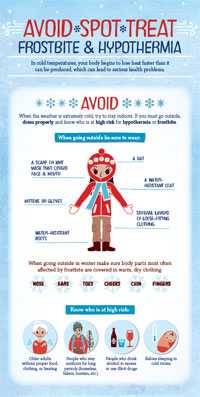Frostbite
Frostbite is a serious condition that’s caused by exposure to extremely cold temperatures. Stay safe this winter by learning more about frostbite, including who is most at risk, signs and symptoms, and what to do if someone develops frostbite.
What is Frostbite?
Frostbite is a bodily injury caused by freezing that results in loss of feeling and color in affected areas. It most often affects the nose, ears, cheeks, chin, fingers, or toes. Frostbite can permanently damage the body, and severe cases can lead to amputation.
Who’s Most at Risk?
You may have a greater risk of developing frostbite if you:
- Have poor blood circulation
- Are not properly dressed for extremely cold temperatures
Recognizing Frostbite
At the first signs of redness or pain in any skin area, get out of the cold or protect any exposed skin—frostbite may be beginning. Any of the following signs may indicate frostbite:
- a white or grayish-yellow skin area
- skin that feels unusually firm or waxy
- numbness
A victim is often unaware of frostbite until someone else points it out because the frozen tissues are numb.
What to Do
If you detect symptoms of frostbite, seek medical care. First determine whether the victim also shows signs of hypothermia. Hypothermia is a more serious medical condition and requires emergency medical assistance.
If (1) there is frostbite but no sign of hypothermia and (2) immediate medical care is not available, proceed as follows:
- Get into a warm room as soon as possible.
- Unless absolutely necessary, do not walk on frostbitten feet or toes—this increases the damage.
- Immerse the affected area in warm—not hot—water (the temperature should be comfortable to the touch for unaffected parts of the body).
- Or, warm the affected area using body heat. For example, the heat of an armpit can be used to warm frostbitten fingers.
- Do not rub the frostbitten area with snow or massage it at all. This can cause more damage.
- Don’t use a heating pad, heat lamp, or the heat of a stove, fireplace, or radiator for warming. Affected areas are numb and can be easily burned.
These procedures are not substitutes for proper medical care. Hypothermia is a medical emergency and frostbite should be evaluated by a health care provider.
Be Prepared
Taking a first aid and emergency resuscitation (CPR) course is a good way to prepare for cold-weather health problems. Knowing what to do is an important part of protecting your health and the health of others.
Taking preventive action is your best defense against having to deal with extreme cold-weather conditions. By preparing your home and car in advance for winter emergencies, and by observing safety precautions during times of extremely cold weather, you can reduce the risk of weather-related health problems.
More Information: Hypothermia
- Page last reviewed: December 20, 2016
- Page last updated: December 20, 2016
- Content source:


 ShareCompartir
ShareCompartir
